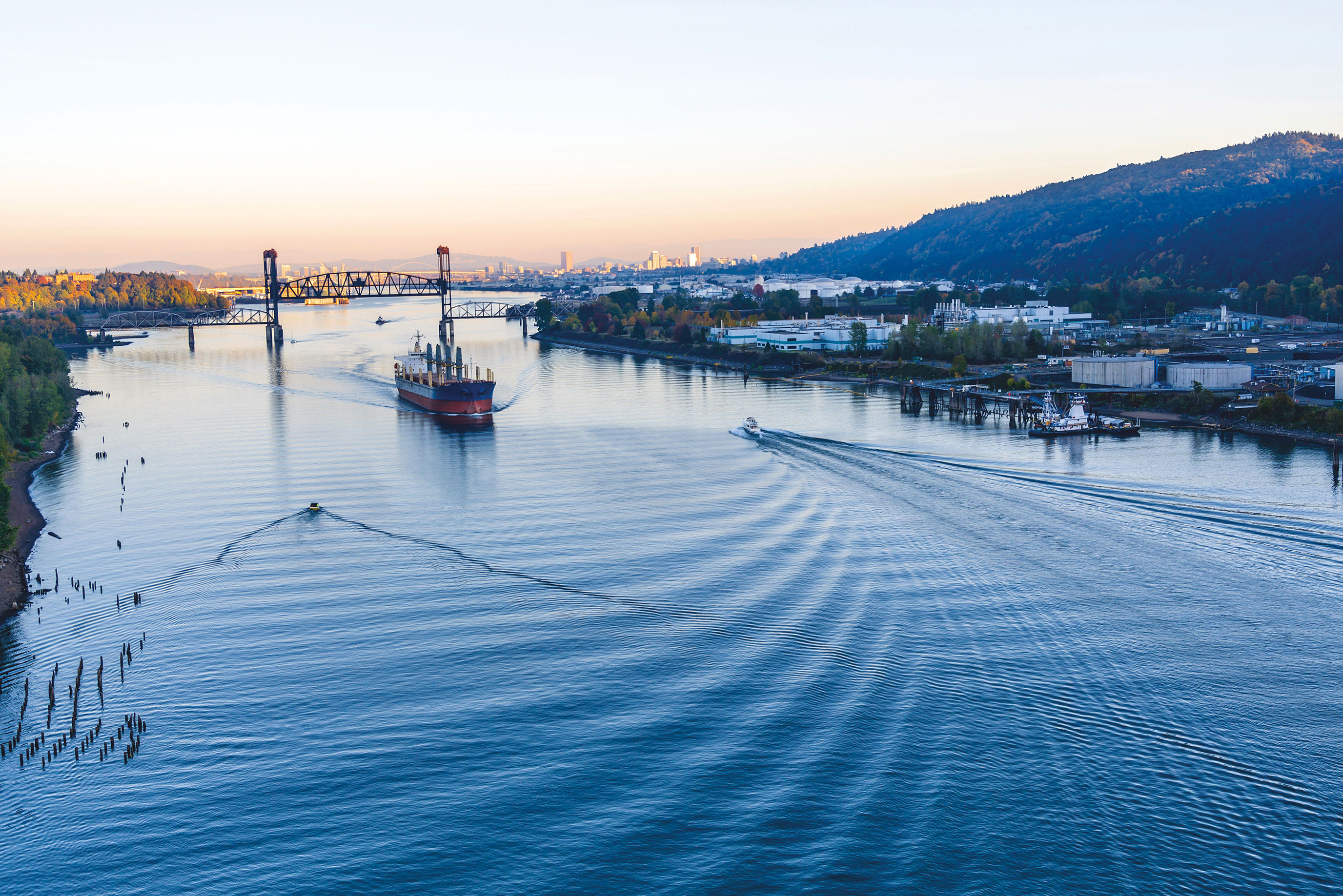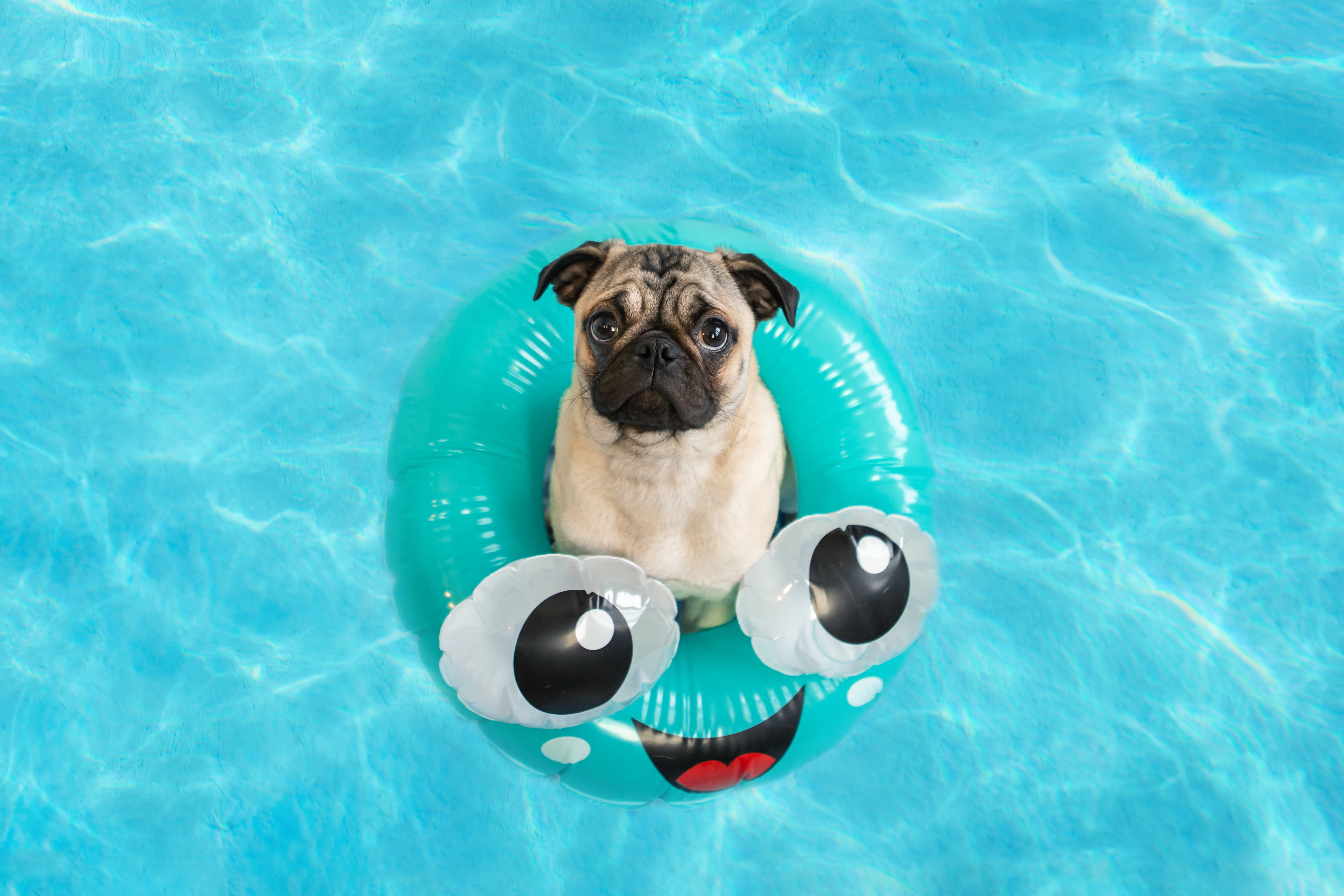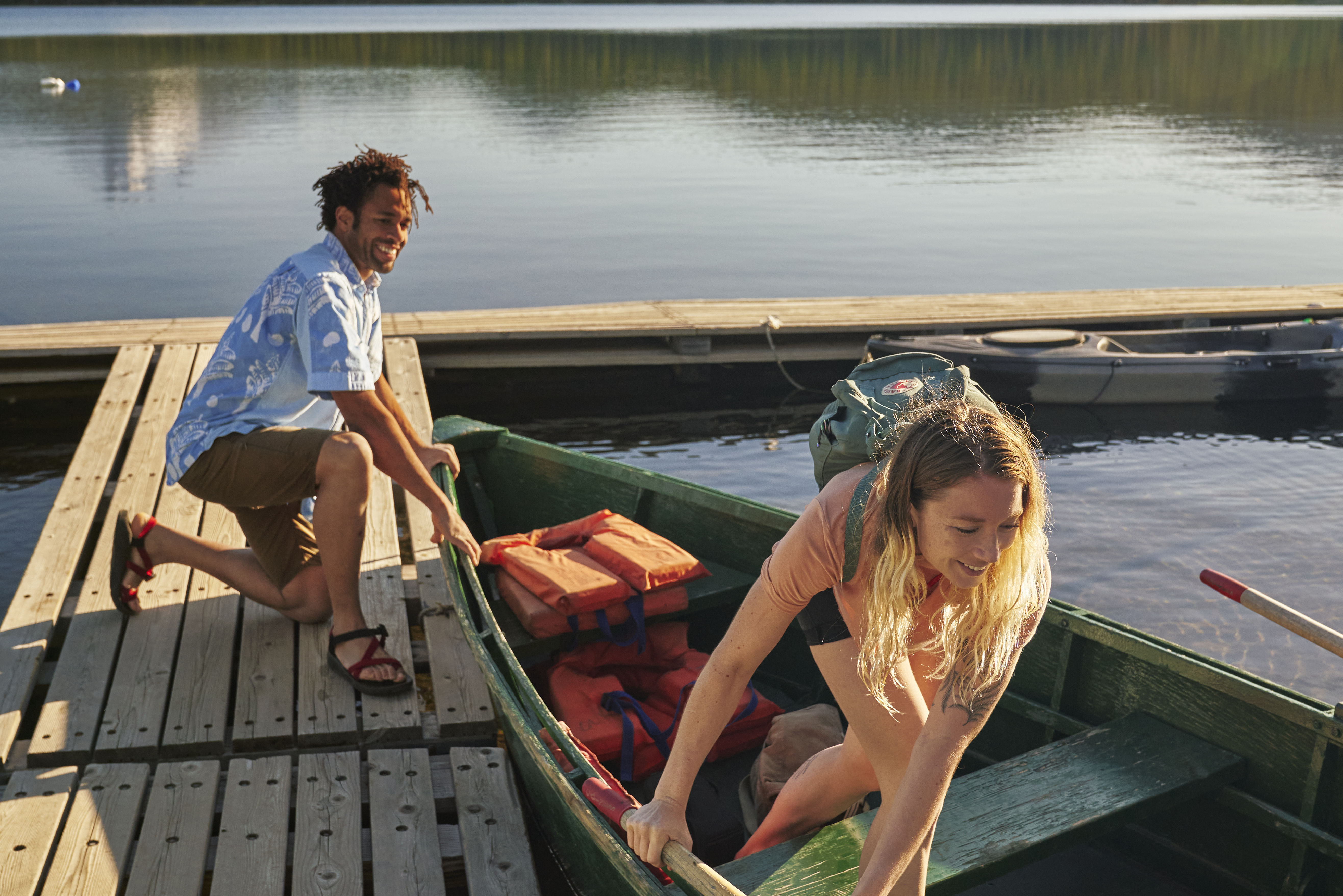
Oregon's Stupendous, Incredible, Magnificent Lake Country
Rent a boat at Olallie Lake Resort (above), but know access to the resort can still be tricky after the 2020 wildfires.
Photograph by Isaac Lane Koval
Oregon is defined by water, from the mighty Pacific at our western edge to the rivers that separate us from Washington and Idaho. But those aren’t our only H2O treasures. Tucked along Oregon’s mountain spine are countless alpine pools beckoning for summer dips, paddles, or just Doug fir whispers and mountain reflections. Note: Wilderness access can depend on current wildfires, past wildfire recovery, road conditions, pandemic staffing, land management projects, weather, and more. Consult the Northwest Interagency Coordination Center as well as National Forest websites and social media before you set out, check with ranger stations, and carry maps for alternate routes. Stay away from fire areas, and remember that lakes near fire areas might involved in firefighting efforts for helicopter bucket fills. And at any lake, pay attention to signs about unseen hazards and health risks.
Here are 15 lakes we love, from north to south, plus a few bonus choices that may or may not be actual lakes.

Most Lost Lake-goers prefer to stake out their spot by the lake and while the day away in its cold-but-not-freezing waters.
Image: Michael Novak
1. Lost Lake
Best for: Floating in an inner tube, canoeing & hiking
Congestion level: High
Permit required: $9 day-use fee
Lost Lake is a misnomer. This gloriously clear lake is very well-known to the hordes of day-trippers happy to make the 90-mile drive from Portland (via I-84 and Hood River). But solitude is beside the point. Motorboat-free Lost Lake is for dinking around in a rented rowboat ($38/hour), tying your floaties together with ropes, or positioning your camp chair so you can dip your toes in the water—all activities best done with a friend or five. If you must ditch your fellow lake-lovers, take the 3.1-mile perimeter trail, or consider nearby Wahtum, Bear, North, or Rainy Lakes, all of which require short hikes to access. But most Lost-goers prefer to stake out their spot by the lake and while the day away in its cold-but-not-freezing waters. Day-use sites come with picnic tables and grills, while overnight options include campsites, cabins, and lodge rooms. —Julia Silverman
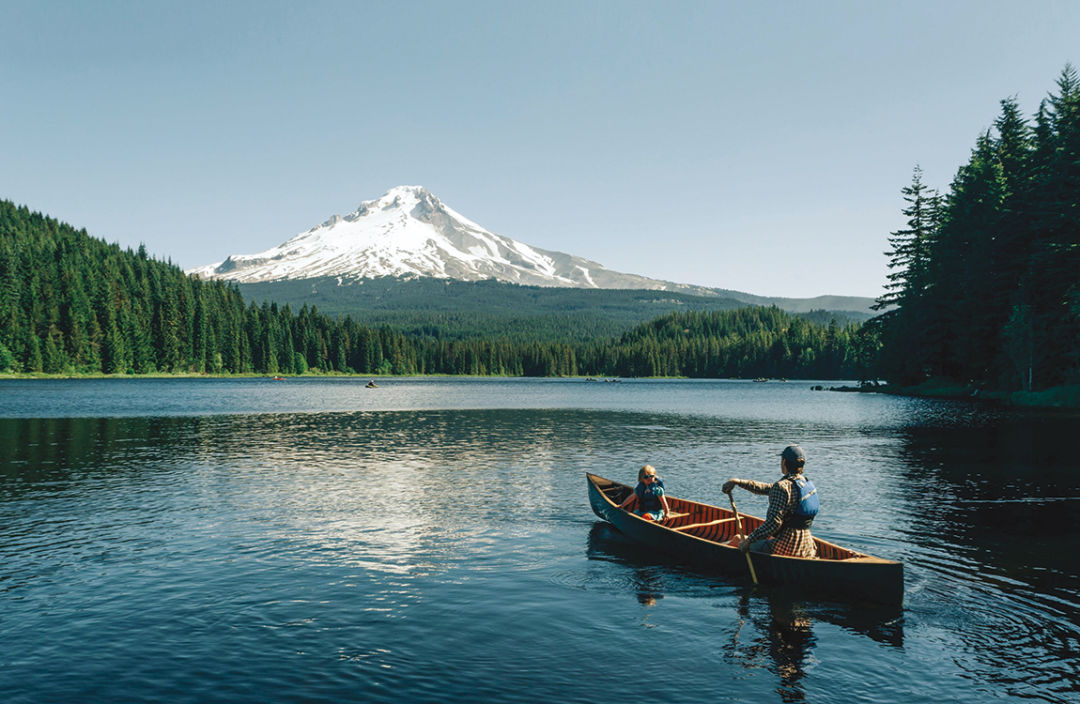
At Trillium Lake, summer brings swimming, fishing, canoeing, birdwatching, and hiking.
2. Trillium Lake
Best for: Peaceful floats with a Mount Hood view
Congestion Level: High
Permit required: Northwest Forest Pass or $5 day-use fee
It may be just off US 26, a mere two miles from bustling Government Camp, and very popular with Portland day-trippers and car campers, but some days you can hear rainbow trout leaping from the still and peaceful waters of Trillium Lake. At this year-round destination, summer brings swimming, fishing, canoeing, bird-watching, and hiking the kid-friendly trail dotted with with wooden boardwalks and hidden creeks and dams. The National Forest campground opens in May. If it’s full (it’s often full), try nearby Still Creek Campground as an alternative. The prettiest views of Mount Hood’s snowy glaciers are from dead-center of the 63-acre lake. Swim or float out and look up—you can’t miss it. —Reina Harwood
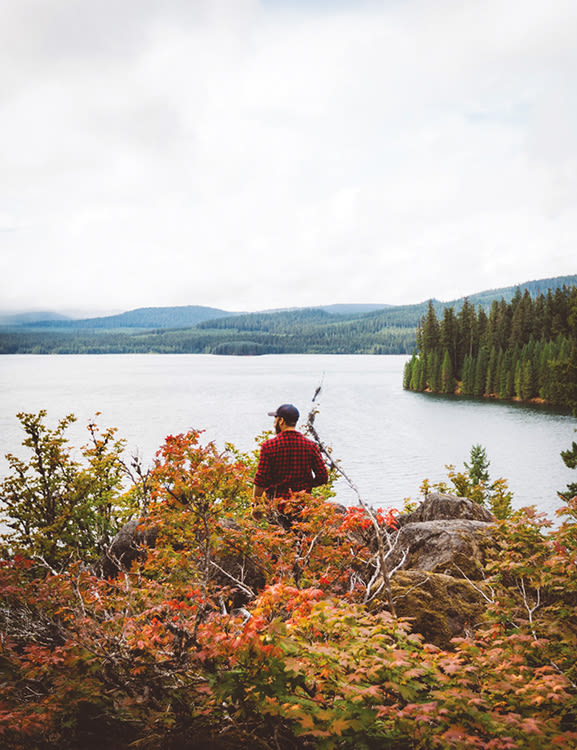
Timothy Lake is a summer family-fun mecca surrounded by campgrounds, boat launches, mountain bike trails, and picnic areas.
3. Timothy Lake
Best for: Puttering about with a fishing pole or just splashing around
Congestion Level: High
Permit required: Northwest Forest Pass or $5 day-use fee
A dammed lake managed by PGE and the Forest Service, the 1,500-acre Timothy Lake is a summer family-fun mecca surrounded by campgrounds, boat launches, mountain bike trails, and picnic areas. The back way, past Estacada and Ripplebrook, was closed by wildfires in 2020, but there’s still easy access via US 26. One of the few Mount Hood lakes to allow motorized boats, Timothy has a 10 mph speed limit. Opening Memorial Day weekend, the south-shore campgrounds are bustling, while the North Arm and walk-in, first come, first served Meditation Point are practically chill. Come back later for fall colors, clearer trails, and plenty of bird-watching. —Margaret Seiler
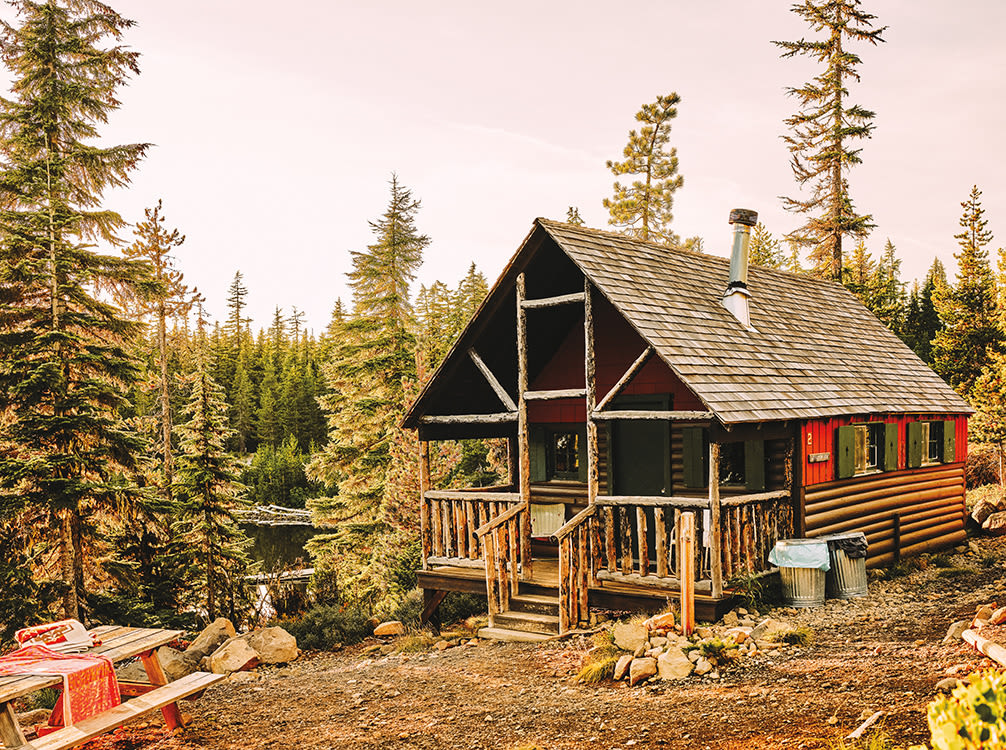
Olallie's cabins survived during 2020's wildfires.
Image: Isaac Lane Koval
4. Olallie Lake
Best for: An old-fashioned family vacation
Congestion level: Medium to high
Permit required: None
Olallie is the largest in a smattering of lakes at the base of Olallie Butte, but it’s stately, snowcapped Mount Jefferson that dominates the view. On the lakeshore, the Olallie Lake Resort survived the horrific wildfires of 2020 except for some damage to its campgrounds. (Thank you, Warm Spring firefighters and many others!) Ongoing fire recovery efforts are still limiting access to the area—check the resort's website for the advice on routes to get there amid road closures. When the time-warp resort is open, you’ll find a tiny, cash-only general store, which rents wooden rowboats to skim the tranquil waters—no motorboats allowed. If you’ve reserved early enough (reservations for the summer usually open January 1), you can stretch your throwback stay into a night or two in one of the 10 rustic, woodstove-heated cabins, most with shared outhouses, or one of the two yurts, which also have space for tent camping alongside. A few warnings, in addition to the uncertain access and operating schedule: Cell service is nonexistent. Water is untreated, so bring your own if you don’t want to shell out at the store. And since Olallie Lake itself is technically a drinking water source, there’s no swimming allowed. There are dozens of other lakes to hike to within the Olallie Lake Scenic Area, though, for a dip. Or hop on the Pacific Crest Trail and keep on walking. —Fiona McCann
5. Scout Lake
Best for: Day-use swimming and picnicking with the gang (and everyone else’s gang)
Congestion level: High
Permit required: Northwest Forest Pass
Just a few minutes off Highway 20 between Hoodoo and Sisters, Scout Lake is no secret. In summer, expect weekend crowds (but no dogs—they aren’t allowed) and weekday busloads from Bend-area youth programs. The 10-site Deschutes National Forest campground isn’t exactly a quiet retreat, either. But if you can snag a parking space, you can probably find a spot for your picnic blanket on the generous beachfront, too. The walk from the parking lot is short and involves no bushwhacking, so you can inflate your giant swan floatie at the car. On the water, watch for logs and try not to bump into anyone else. Afterward, grab a snack and a beer at the Suttle Lodge’s Boathouse restaurant by the much larger Suttle Lake. —MS
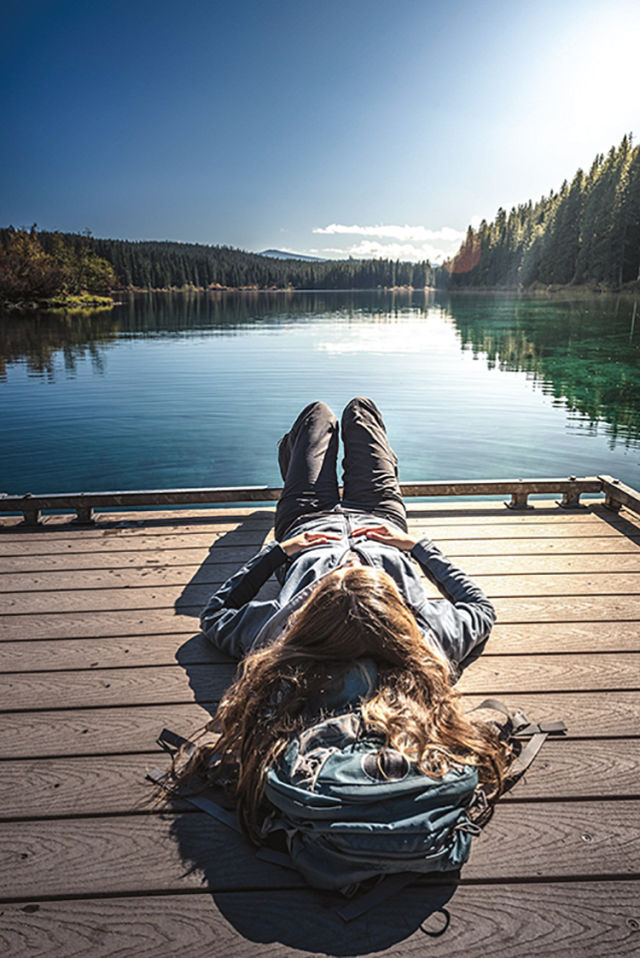
The real show at Clear Lake is underwater.
6. Clear Lake
Best for: Fishing, paddling, diving, and geology lessons
Congestion level: High
Permit required: $5 fee to launch personal watercraft at Clear Lake Resort, $8 day-use fee at Cold Water Cove
The surrounding green forests and blue sky are pretty, sure, but the real show at Clear Lake, which was formed after a volcanic eruption some 3,000 years ago and sits along OR-126 between Eugene and Bend, is underwater. Look down from your stand-up paddleboard or rented rowboat (no motors allowed) to see millennia-old tree trunks preserved in water that’s barely above freezing. Part of Linn County Parks, Clear Lake Resort rents cabins and rowboats year-round, and there’s a seasonal Forest Service campground at the opposite end of the lake, Cold Water Cove. A flat hike all the way around makes for a pleasant afternoon ramble, the trout-stocked lake is great for fishing, and the sunken forest is popular with divers; scuba shops in Portland, Salem, and Bend sometimes offer guided adventures here. —MS
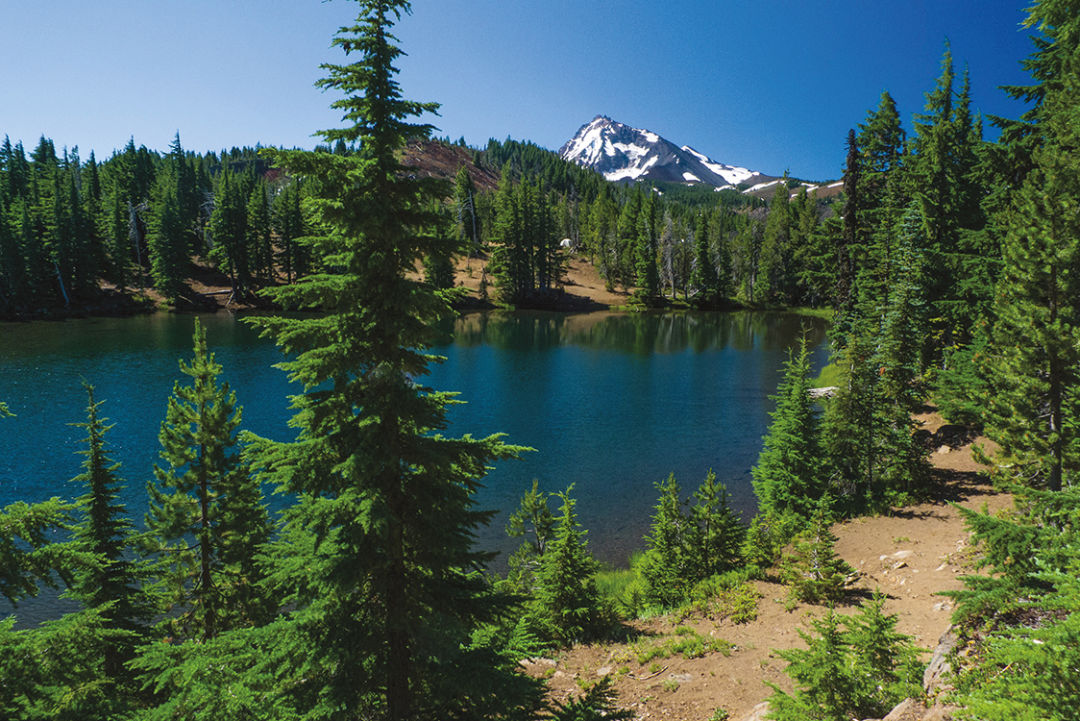
South Matthieu Lake
7 & 8. Matthieu Lakes
Best for: Day hike to a swim or low-mileage overnighter
Congestion level: Moderate to high
Permit required: Wilderness permit for day-use and overnight
Soon after the McKenzie Pass is clear of snow and the McKenzie Highway cutoff between Eugene and Bend opens for the season, usually in late June, expect the route to be lined with eye-popping wildflowers growing among black rocks like springtime in Mordor. Just east of the Dee Wright Observatory (its Middle-earth equivalent would be Weathertop), park at the Lava Camp Lake trailhead and set off. You’re likely to pass dusty northbound Pacific Crest Trail hikers well into their own epic quest. At roughly three-quarters of a mile from the starting point, stay to the right to hike this as a six-mile loop in the counter-clockwise direction, hitting North Matthieu Lake first: a spacious emerald-blue expanse with an island in the center, sheltered in a basin of thick evergreen forest. Continue south to South Matthieu Lake, a miniature of the first—this one in a high-alpine setting with excellent views of North and Middle Sister in the distance. Snag one of the few designated campsites at either campground or take a life-affirming plunge and complete your loop along the PCT, climbing steadily over a barren, fire-torn ridge with incredible views of Mounts Washington and Jefferson. —Benjamin Tepler
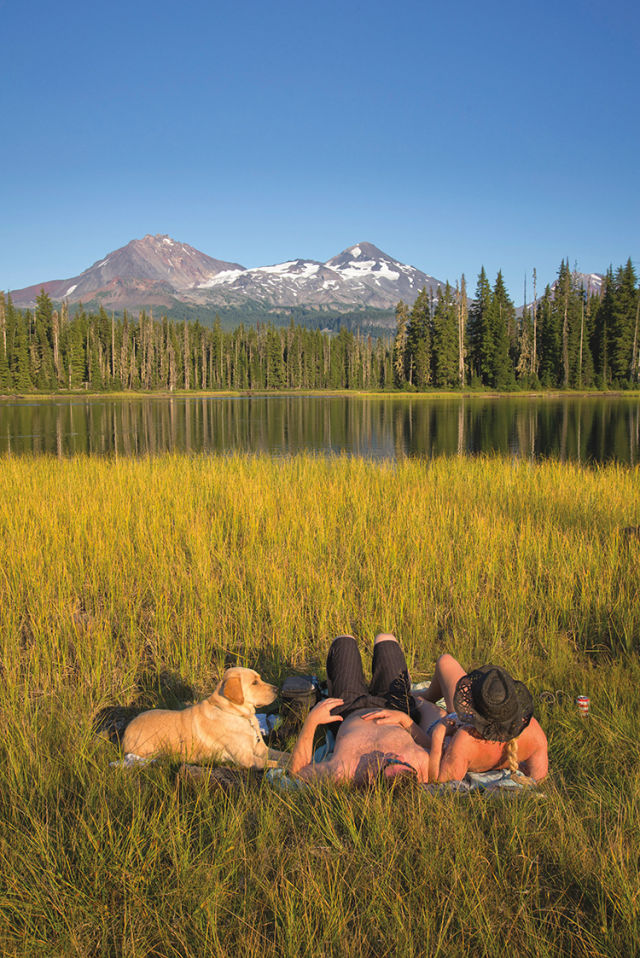
Scott Lake
9. Scott Lake
Best for: Family car camping
Congestion level: Moderate to high
Permit required: Northwest Forest Pass or $5 day-use fee
Scott Lake, a popular Bend escape, is actually three small lakes strung together at the base of Scott “Mountain.” (about 6,000 feet). The water is warm, and expect feet to sink into the volcanic silt bottom. It’s a prime basecamp for anyone who’s snagged a limited-entry permit to the popular, volcanic Obsidian Trail, which stretches 14.5 miles southeast of Scott Lake. A dusty forest road leads all the way to the primitive Scott Lake campground, so you can technically treat this as a car camp. Those parking-adjacent sites fill up quickly, however, and you’ll likely be looking for those famous Scott Lake views you’ve heard about: the glassy reflection of the snowcapped Three Sisters trio to the north. Pack a collapsible wagon, throw your goodies (and children, if applicable) inside, and cart off along a path accessing the three petite swimming holes until you’ve found your spot. —BT
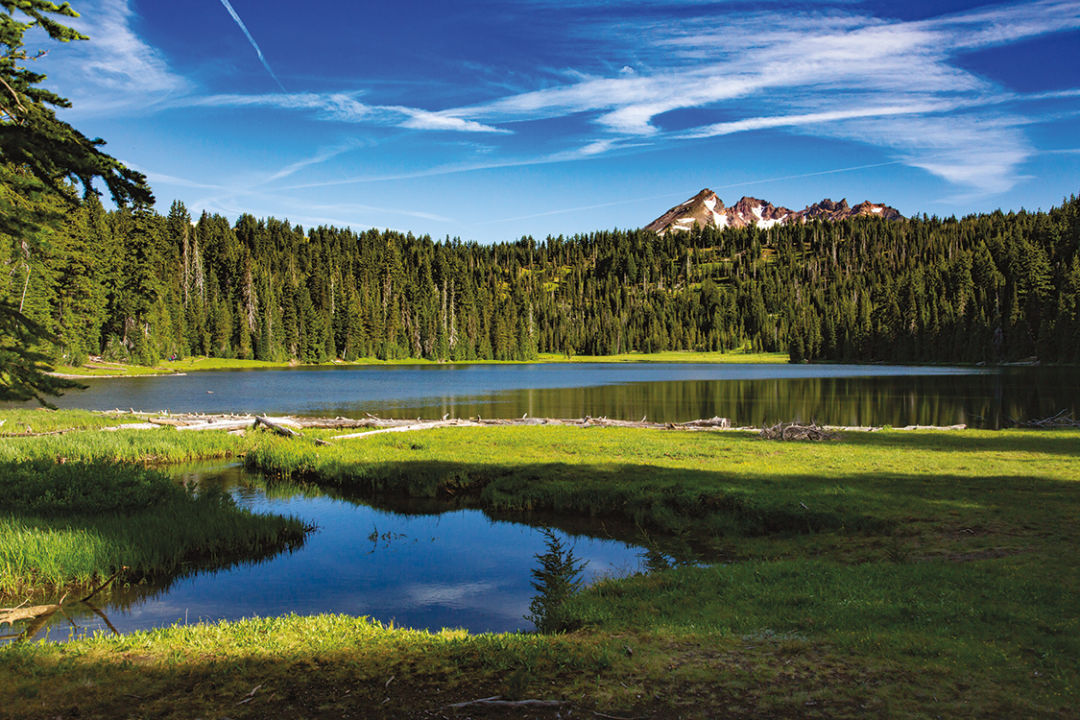
Todd Lake offers deep, cool waters with ample access points.
10. Todd Lake
Best for: Flower freaks and photo ops
Congestion level: High
Permit required: Northwest Forest Pass or $5 day-use fee; wilderness permit
Formed in the basin of an ancient dacite volcano along the Cascade Lakes Highway, Todd Lake offers deep, cool waters with ample access points. The best swimming is found at the north end of the lake in a marshy meadow. You can stay in one of the three walk-in Forest Service campsites—no. 2 is the only one with a lake view. The trail around the lake, just 1.7 miles, takes you through groves of mountain hemlock and noble pine to a meadow full of subalpine lupine, Indian paintbrush, and alpine aster, complete with a stunning view of Mount Bachelor. About 24 miles from Bend along a paved road, Todd Lake is easy to get to and, thus, quite popular as a daytime excursion. Have a backup plan if the campsites are full. —Kiva Hanson
11. Lucky Lake
Best for: Rocky lagoon fantasies
Congestion level: Low to moderate
Permit required: Northwest Forest Pass or $5 day-use fee; wilderness permit
Clear waters, low use, and warmer water temperatures make this one of the best swim spots in the Cascades. Lucky Lake is accessed by the Senoj Lake Trail, and with the Three Sisters Wilderness beginning about a half-mile into the trail, backcountry camping can easily extend the stay. The lake is about two miles from the trailhead, and the walk there is mostly flat except for the last quarter-mile. After cresting the hill, follow the trail to the right to find a number of small rocky enclaves with amazing lake access. Rotate between swimming and sunning yourself on the large boulders, and you just might have found a slice of paradise. —KH
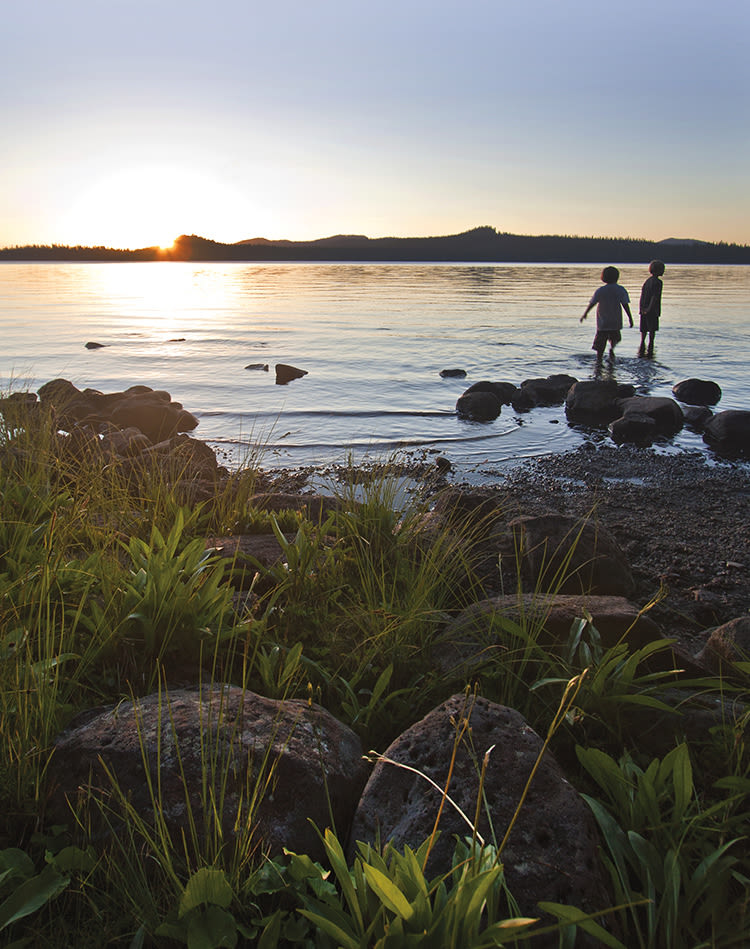
Waldo Lake is one of the biggest lakes in Oregon.
12. Waldo Lake
Best for: A group-camp friend or family reunion, if you can get a reservation
Congestion level: High
Permit required: Wilderness permit required for all but the eastern shore
At nearly 10 square miles, Waldo is one of the biggest lakes in Oregon, and one of the purest, too, fed by snowmelt and free of plants and fish in its clear depths. And it’s one of the busiest, with more than 200 campsites distributed among the three campgrounds on its eastern shore. Don’t come here for peace and quiet, with splashing and squealing kids soundtracking the day and guitars and Bluetooth speakers coming out after dark. (If the beach gets too crowded, take a Forest Service road up to tiny Irish and Taylor Lakes instead, where you’ll run into Pacific Crest Trail hikers but not too many others.) A 20-mile trail popular with mountain bikers rings Waldo, and visitors can reach the far more chill Waldo Lake Wilderness Area on the western and northern shore by boat, too. Electric motors are allowed at limited speeds, though there always seem to be ongoing campaigns to allow gas motors or ban motorized boats altogether. —MS
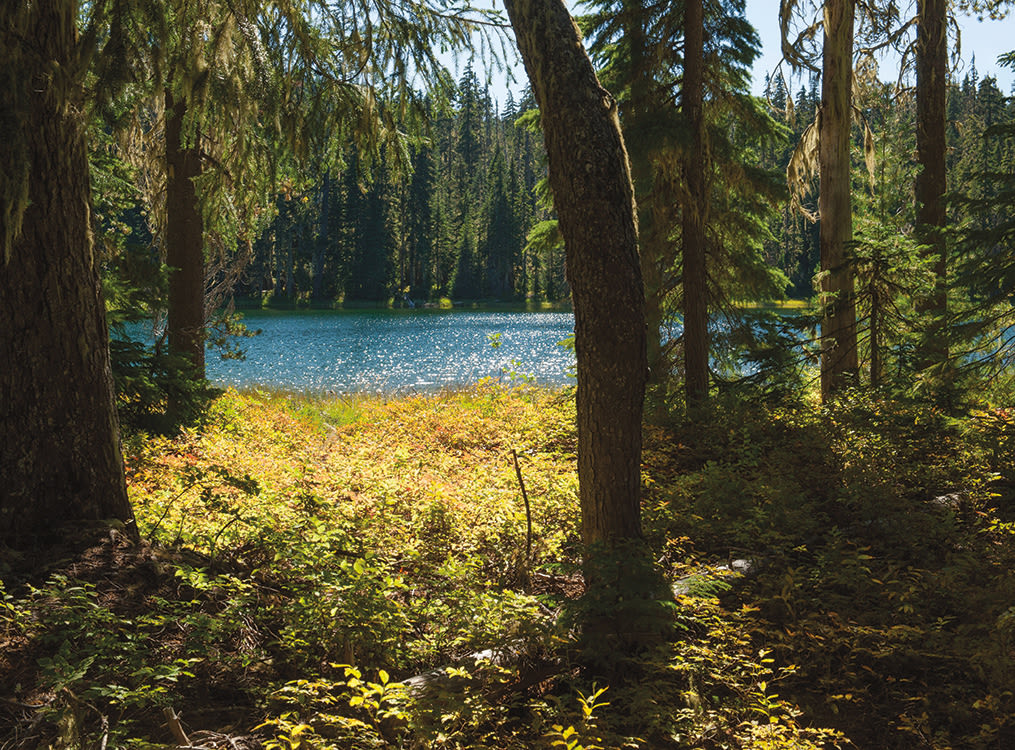
Timpanogas Lake offers lovely swimming and access to 20-plus miles of trails.
13. Timpanogas Lake
Best for: Not-too-rustic camping
Congestion level: Moderate to high
Permit required: None
Surrounded by Diamond, Sawtooth, and Cowhorn peaks, this lake offers lovely swimming and access to 20-plus miles of trails. It’s the start of the Middle Fork of the mighty Willamette River (as opposed to the start of the Willamette’s North Fork Middle Fork—that’s Waldo.) Timpanogas Lake isn’t necessarily easy to get to, with gravel roads taking you the last eight miles. But with a 10-site campground and rentable rustic shelter, you can stay awhile. The loop around the lake leads through alpine forest at 5,300 feet. Mountain views, trail access, and crystal-clear waters make it a great spot for a summer weekend. —KH
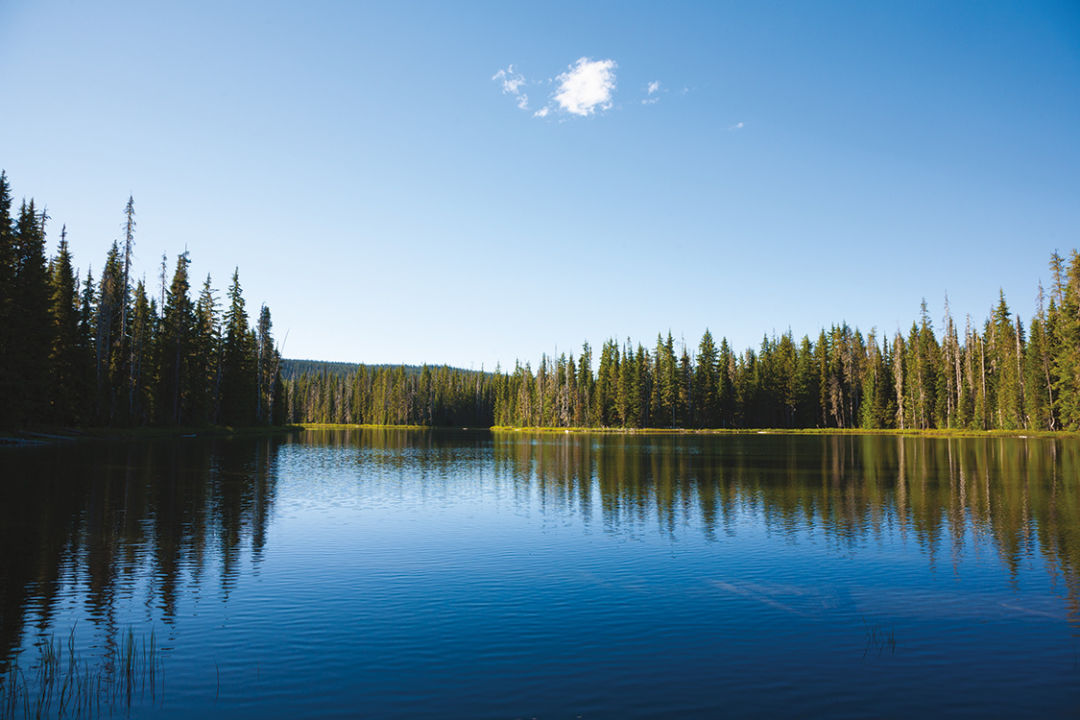
Indigo Lake offers lakeside alone time.
14. Indigo Lake
Best for: Contemplative me time
Congestion level: Low to moderate
Permit required: None
Looking for some lakeside alone time? Try Indigo Lake, reached via a 1.9-mile hike from Timpanogas Lake to the foot of Sawtooth Mountain in the Willamette National Forest. Pass through wildflower meadows and groves of mountain hemlock and Pacific silver fir to a clear, deep-blue lake true to its name. At 5,900 feet, the water can be bracing. There are some primitive campsites and steady trail traffic, including mountain bikers, but there’s still plenty of solitude to be found. —KH
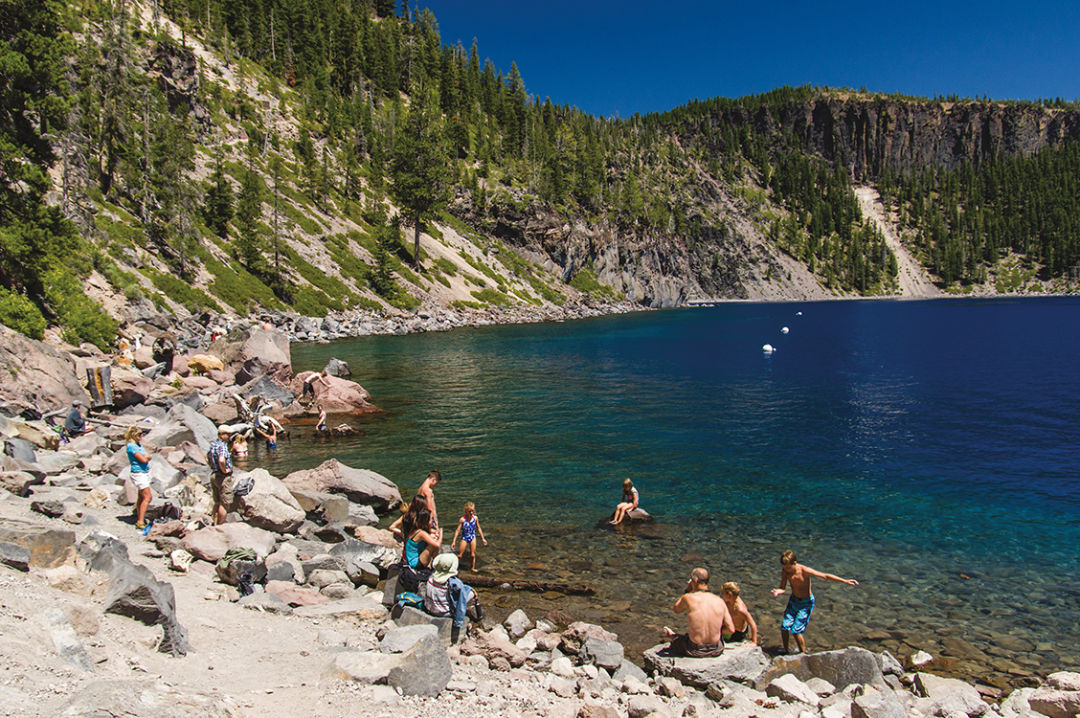
Crater Lake
15. Crater Lake
Best for: Budding geologists and bucket-list makers
Congestion Level: High
Permit required: $20–30 per vehicle for a seven-day pass
Crater Lake itself dates back millennia, from the formation of Mount Mazama to the eruption about 7,700 years ago creating the caldera that now holds the country’s deepest lake, almost bottomless at 1,943 feet. But its protected status as a national park is much more recent. Just over a decade after the 1872 designation of the country’s first national park, Yellowstone, a Portlander named William Steel visited the shockingly blue, steep-walled mountain lake he had only read about—and soon made it his mission to secure similar protections. Starting in 1885 he advocated for a bill to permanently protect the land, studying the area’s ecosystems to draft a petition and survey to sway Congress and the public alike. He soon teamed up with John Waldo, a former Oregon Supreme Court justice (and the namesake of Oregon’s second-largest lake—see lake no. 12, above). In 1894 Steel cofounded the Mazamas, an alpine climbing group still active today, which joined the lobbying effort. (The mountain was named after the group.) Congress wasn’t keen on funding the services and infrastructure that came with a national park, but finally, in 1902, President Theodore Roosevelt signed a bill into law making Crater Lake the country’s fifth national park. Since then, efforts to extend the park’s boundaries to include Diamond Lake have failed, as have ideas for more national parks in Oregon at Hells Canyon, the coast, Owyhee Canyonlands, and elsewhere.
Most of the 700,000 or so annual visitors to Crater Lake National Park don’t go in the water, content instead to see what was once called Lake Majesty from the ridge above along the 33-mile Rim Drive, which usually opens in July when the high-elevation snow finally melts. (In 2021 the full road opened earlier than usual, on June 25.) From stops like Discovery Point and Watchman Overlook, gawkers can spot volcanic spires, stream-cut canyons, whitebark pines, soaring bald eagles, up to 60 species of butterflies, and, of course, the lake itself. The only legal swimmer’s access to the water is at Cleetwood Cove (above), down a steep 1.1-mile trail, and floaties, rafts, and even goggles are banned “to protect the clarity of the lake.” The Pacific Crest Trail passes through the park, and a lodge on the lake rim and cabins and campgrounds a few miles away bring a steady stream of visitors in nonpandemic years. —RH
Bonus! Oregon’s Other ‘Great Lakes’

Image: Michael Novak
Or are they all even lakes? Do we care? No.
- It might have been the Oregon Dunes near Florence that inspired the setting for Frank Herbert’s Nebula Award–winning novel Dune, but Tillamook County’s Sand Lake Recreation Area is a much closer spot to ponder the spice—or just ride a dune buggy or ATV.
- While there once was a lake view in Lakeview, irrigation practices have shrunken Goose Lake. All the lakes in Lake County were bigger in the Pleistocene Era but are still impressive from above, especially to the Canada geese and other birds that make regular stops.
- Civil rights and community lawyer Lake Perriguey was a lead attorney on the case that determined the state’s ban on same-sex marriage was unconstitutional. A year later, the rest of the country caught up. Way to make Oregon a leader, Lake.
- Lake on lakes?! Perriguey, of course, knows a good lake when he sees one, and is partial to Serene Lake in the Mt Hood National Forest. “You can swim the length of it, back and forth, like a pool,” he says. “The old growth and naturally occurring rhododendron are so beautiful.”
- Lake Oswego’s namesake natural pool was once called Sucker Lake for its easy fishing. Now it’s a schmancy burb with an out-of-place Iroquois name, its own Salt & Straw location, a super-friendly bike shop, and a perpetual water access dispute.
- The tiny, 45-feet-deep, spring-fed, crystal-clear, always practically freezing Little Crater Lake, between Timothy Lake and US 26, should really be called Little Clear Lake (see no. 6, above). Can Clear Lake get no respect? Must it always be Jan to Crater’s Marcia?
- The lake it might have looked out on, Guild’s Lake, was filled in 100 years ago. But dang if short-lived Northwest haunt Rae’s Lakeview Lounge (now the site of the Impala Bar and Grill) didn’t have a perfect patio brunch and the perfect price on happy-hour Rainiers. —MS
